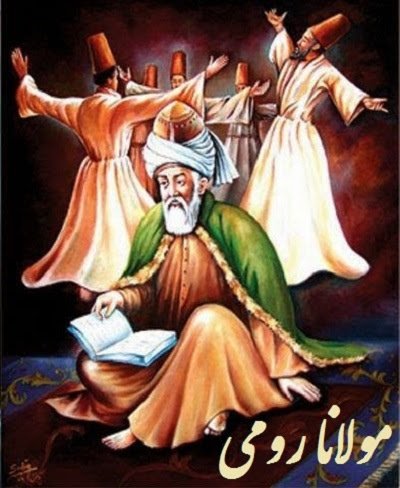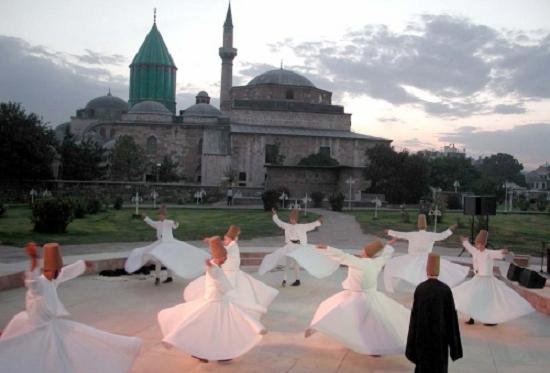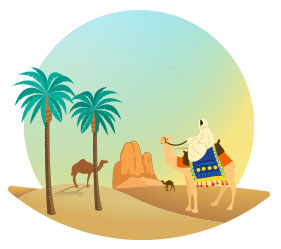Maulana Jalaluddin Al-Rumi

Maulana Jalaluddin Al-Rumi (1): Muhammad Bin “Sultan Al-‘Ulama” (Sultan of the Scholars) Baha’uddin Muhammad Bin Al-Husayn Bin Muhammad Bin Ahmed Bin Qasim Bin Musayyib (or “Habib,” according to some sources) Bin Abdullah Bin Abdel-Rahman Bin Abi Bakr Al-Siddiq was from the tribe of Quraysh and a descendant of Abu Bakr Al-Siddiq whose ancestors can be traced to Khatibi, Balkh, and Konya. Known as Maulana Jalaluddin Al-Rumi, or “Mullah Khonkar,”he was the great Sufi poet who wrote the Masnavi. He was given the title of “Maulana” after his death, and the Mawlaw’iyya (Mevlevi) Order, also known as the Whirling Dervishes, was founded by him.
Jalaluddin Al-Rumi was born in Balkh on the 6th of Rabi’ Al-Awwal of 604 AH (1207 AD). His mother was the sister of the King of Khwarezm-Shah Ala’ ad-Din Muhammad, although some sources say it was actually his paternal grandmother who was the sister of King Khwarezm-Shah. His grandfather (Husayn) married the daughter of Ala’ Al-Din Bin Muhammad Bin Khwarezm-Shah, and the mother of his second great-grandfather (Ahmed Bin Qasim) was the sister of Sultan Ibrahim Bin Adham. He moved with his father at the age of four to Baghdad in 607 AH, but his father did not stay there. He traveled with him to many different cities, including Damascus and Makkah, until he finally settled in Konya, Anatolia in 623 AH.
Another narration regarding Rumi’s lineage says that his name was: Jalaluddin Muhammad Bin Baha’uddin Muhammad Bin Husayn Bin Ahmed Bin Mahmoud Bin Mawdud (or “Mawrud”) Bin Thabit Bin Musayyib Bin Mutahir (or “Muthahir”) Bin Hammad Bin Abdel-Rahman Bin Abi Bakr Al-Siddiq—may Allah be pleased with them all.
Murtada Al-Zabidi (d. 1205 AH) mentioned Konya in Taj Al-Arus (spelling it in Arabic with a damma on the letter qaf, a kasra on the letter nun, and no shadda on the letter ya’) saying: “The founder of the Order, Imam Jalaluddin Al-Hasani Bin Muhammad Al-Bakri, the author of the Masnavi known as Mullah Khondkar (2), was from there.” In response, I say: The author of the Masnavi was Maulana Jalaluddin Al-Rumi of Konya, so perhaps they are the same person.
Maulana Jalaluddin was a scholar of the madhab of Abu Hanifa and had great knowledge of jurisprudence, the differences of opinion in different schools of thought, and other branches of knowledge. He was appointed to teach in four different schools in Konya, replacing his father, who died in 628 AH. He taught the sciences of jurisprudence, hadith, and tafsir (Qur’an exegesis).
The prominent scholar Sheikh Qutb Al-Din Al-Shirazi, known for his commentary on Miftah Al-ʿUlum, spent time with Jalaluddin Al-Rumi. Debates took place between them, eventually leading him to leave teaching and writing. He isolated himself and became a Sufi in around 642 AH. He left his children and his schools and traveled to different countries, occupying himself with writing poetry. His poems were mostly written in Persian and represent a complete body of Sufi literature. He began writing the Masnavi, a famous poem of nearly 25,000 verses filled with wise sayings, proverbs, and information, in 662 AH and continued until around 672 AH. The Masnavi is so well-known that it requires no introduction and is, as its author described it: “The roots of the religion in regard to unveiling the secrets of wusul (obtaining connection to Allah) and yaqin (spiritual certainty), which is the greater knowledge of Allah.”
Among his other writings are: Asrarnama (about Sufism), Lubb Al-Lubab, Fihi Ma Fihi (which contains stories, sermons, and sayings), and Al-Majalis Al-Sab’ah (which contains sermons and speeches he gave while teaching). His works of poetry, including the Masnavi, are in Persian. He also wrote: Diwan Shams Tabrizi, consisting of around 3,500 verses of Sufi ghazals, and Al-Ruba’iyat, which contains 1,659 quatrains and 3,318 verses.
Jalaluddin Al-Rumi is amongst the world’s most prominent Sufi poets and was the founder of his Sufi Order, Al-Mawlaw’iyya. He died in Konya and was buried there in his famous tekke (the Mevlana Lodge) on the 5th of Jumada Al-Thani in 672 AH (1274 AD). A magnificent shrine was built over his tomb. The last piece of advice he gave to his students was: “I advise you to fear Allah inwardly and outwardly; to sleep, eat, and speak little; to abandon disobedience and sin; to observe fasting and always stand up for prayer at night; to continuously abandon desires; to bear people’s rudeness; to abandon the gatherings of the foolish and people of ill-repute; and to befriend those who are righteous and honorable, because the best of people is he who benefits others, and the best of speech is short and concise.”
Jalaluddin Al-Rumi’s father was Baha’uddin Muhammad Bin Husayn Al-Khatibi Al-Balkhi, who was also known as Baha’ Walad and “Sultan Al-‘Ulama” (Sultan of the Scholars). He authored Al-Ma’arif, which was basically a book of sermons and lectures he gave and organized himself in which he explained what it means to know Allah and discussed faith and the meanings of the Qur’anic verses. The majority of the book’s chapters begin with the phrases “I said to myself” and “I thought to myself.” Starting in childhood, he had a great influence on his son’s interests and leanings.
Source: Kitab Al-Sulala Al-Bakria As-Siddiqia – Part II, by Ahmed Farghal Al-De’abassi Al-Bakri
Date of Publication
1 Ramadan 1438 AH / May 26, 2017 AD
(1) Sullam Al-Wusul ila Tabaqat Al-Fuhul 3/ 248, Hidayat-ul-Arifeen 2/ 130, Al-A’lam, by Al-Zarkali 7/ 30, ‘Iqd al-Juman fi Tarikh Ahl al-Zaman 2/ 128-129, Taj Al-Tarajim, by Ibn Qutlubugha 1/ 246, Nahr Al-Dhahab fi Tarikh Halab 2/ 234, Ruh Al-Bayan, by Abu Al-Fida’ Isma’il 2/ 448-449, Miftah Al-Sa’ada wa Misbah Al-Siyada 2/ 258-261, Bayt Al-Siddiq, pp. 227-228, The Story of Civilization, by Will Durant 13/ 349-350, Al-Mausu’ah Al-Sufia, pp. 183-186
(2) Taj Al-Arus 36/ 29
 In front of Maulana Jalaluddin Al-Rumi’s shrine in Konya, Turkey.
In front of Maulana Jalaluddin Al-Rumi’s shrine in Konya, Turkey.
